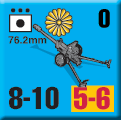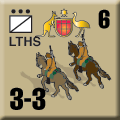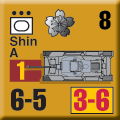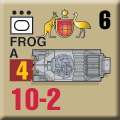| Panzer Grenadier: Waltzing Matilda
Scenario Overview
October 2014
Waltzing Matilda was a downloadable supplement in our Panzer Grenadier series exploring what might have happened if Japan’s invasion of the South Seas had gone beyond the oil-rich Spice Islands to Australia. A huge undertaking in any event, the invasion of Australia would have required a major commitment of highly mobile Japanese formations to cover the long overland distances involved and deal with the equally mobile Australian militia forces.
As a result, Waltzing Matilda includes a full sheet of Japanese counters with tanks and cavalry not seen before in the Panzer Grenadier series, plus another sheet of new Australian units including the famous Light Horse and other units that would have seen combat in the defense of Australia. The module also gives Japanese forces the opportunity to fight and maneuver in open, unrestricted terrain. That’s something they’ve rarely been able to do in our previous Panzer Grenadier games and supplements, so Waltzing Matilda provides a very different tactical combat experience from Guadalcanal, Jungle Fighting, Alaska’s War or Kokoda Trail.
What follows is a summary of the scenarios in Waltzing Matilda with some commentary. We hope you enjoy them.
Scenario One
Darwin's Theory
May 1942
 While a full-blown invasion of Australia was at best a remote possibility, the Allied command had to take threats against the northern port of Darwin seriously. The Japanese did not actually contemplate a leap across the Timor Sea from Java, but did make a devastating air raid on the port in February 1942. Isolated from the rest of Australia, Darwin had only a small garrison to protect it from the Japanese. While a full-blown invasion of Australia was at best a remote possibility, the Allied command had to take threats against the northern port of Darwin seriously. The Japanese did not actually contemplate a leap across the Timor Sea from Java, but did make a devastating air raid on the port in February 1942. Isolated from the rest of Australia, Darwin had only a small garrison to protect it from the Japanese.
Note: This scenario uses boards from Eastern Front and Road to Berlin, and pieces from Guadalcanal and Afrika Korps.
Conclusion
Protected by swamps and other harsh terrain to a small extent, Darwin offered port and airfield facilities that threatened the Japanese hold on the Dutch East Indies. Raids launched there would annoy the Japanese throughout the war, but they did not move to actually capture the Northern Territory's capital. All-weather roads would eventually be built to link Darwin with the rest of Australia, but in the war's early months reinforcing the area took a major effort.
Commentary
Here a large but unsupported Japanese infantry force attacks the outskirts of Darwin, encountering resistance from elements of the well-trained Australian 3rd Infantry Brigade. Despite their lack of armor support, the elite Japanese first-wave forces have one of the most deadly weapons in the whole Panzer Grenadier arsenal: a fanatical morale level of 9/8.
Scenario Two
First Wave
August 1942
While the AIF practiced mobile warfare in the Western Desert, Australia's Northern Command did not intend to follow suit in case of a Japanese invasion. Australian units would stand and fight where they stood, with Maj. Gen. George Vasey counting on his troops' expected fanaticism to hold out long enough for reinforcements to arrive. That would relieve inexperienced troops of the need to maneuver while in contact with the enemy, but could expose them to intense combat.
Note: This scenario uses boards from Road to Berlin and pieces from Guadalcanal and Afrika Korps.
Conclusion
 Japan's elite naval infantry would have spearheaded any assault on Australia — the invasion was the Navy's idea, and the Navy would have had to throw in all of its land forces to make it work. Australia's citizen soldiers were not nearly the equal of the "Japanese marines" in fighting ability, but standing on Australian soil would have made a huge difference in their performance. Japan's elite naval infantry would have spearheaded any assault on Australia — the invasion was the Navy's idea, and the Navy would have had to throw in all of its land forces to make it work. Australia's citizen soldiers were not nearly the equal of the "Japanese marines" in fighting ability, but standing on Australian soil would have made a huge difference in their performance.
Commentary
The Japanese have a numerical advantage of nearly 3 to 1, armor support and higher morale. So to give the Aussies a chance I cut the game to 16 turns, put the full burden of victory on the Japanese and broadened the objectives a bit to force the Japanese to spread out their units. The Japanese player wins if at the end of play all town and high-elevation hill hexes are free of undemoralized Australian combat units. Any other result is an Australian victory.
Scenario Three
Dutch Treat
August 1942
 When the Netherlands East Indies collapsed in the spring of 1942, a shipment of light tanks purchased by the Dutch in the United States went to Australia instead. These two-man tanks, built by Marmon-Herrington, were nearly useless in battle but the Australians gratefully accepted anything they could get. Had the Japanese invaded, the little vehicles would have been thrown into battle — Japanese tanks, after all, weren't that much better. When the Netherlands East Indies collapsed in the spring of 1942, a shipment of light tanks purchased by the Dutch in the United States went to Australia instead. These two-man tanks, built by Marmon-Herrington, were nearly useless in battle but the Australians gratefully accepted anything they could get. Had the Japanese invaded, the little vehicles would have been thrown into battle — Japanese tanks, after all, weren't that much better.
Note: This scenario uses boards from Eastern Front and Road to Berlin, and pieces from Guadalcanal and Afrika Korps.
Conclusion
Given the huge expanse of territory, the forces involved — 10 divisions for the Japanese, nine for the Australians — would have usually fought in meeting and flanking engagements rather than frontal assaults. The doctrine of rapid movement (sokusen sokhetsu) developed in China required the Japanese to attempt encirclement of their enemies, but the Australians had their own maneuver doctrines developed in Palestine in 1918 and the Western Desert in 1940.
Commentary
The Japanese enter on the east edge and the Australians on the west edge, and not all units have to enter on the first turn. That lets both sides do a bit of feint and counter-feint in the early going to see who’s entering where, and also lets the Aussies set up roadblocks early on. Since the Aussies have nearly no AT capability, all they can hope to do is bog the Japanese tanks down in assaults.
Scenario Four
Brisbane Line
August 1942
 Just how the Allied command planned to defend Australia would become a controversial topic in mid-war elections, and continue to simmer into the next century. Supporters of John Curtin, prime minister in 1942, charged his predecessor, Robert Menzies, with scheming to fall back to a "Brisbane Line" that abandoned much of Queensland to the Japanese. There seems to have been no actual "Brisbane Line," and Maj. Gen. George Vasey of Northern Command told his subordinates that he expected them to fight "to the limits of human endurance" for every inch of their country. Just how the Allied command planned to defend Australia would become a controversial topic in mid-war elections, and continue to simmer into the next century. Supporters of John Curtin, prime minister in 1942, charged his predecessor, Robert Menzies, with scheming to fall back to a "Brisbane Line" that abandoned much of Queensland to the Japanese. There seems to have been no actual "Brisbane Line," and Maj. Gen. George Vasey of Northern Command told his subordinates that he expected them to fight "to the limits of human endurance" for every inch of their country.
Note: This scenario uses boards from Eastern Front, Battle of the Bulge, Road to Berlin and Elsenborn Ridge, and pieces from Guadalcanal, Afrika Korps and Secret Weapons.
Conclusion
Australia's vast size would have demanded that her defenders give up something - the continent's small population base made that inevitable. But saying so out loud was anathema in a democratic society, and the Australian people were most definitely willing to back up their unreasonable demands with unreasonable fighting fury. Whether that would have been enough against a well-supported invasion was fortunately never tested.
Commentary
The Australians will have to make good use of their reserves and their mobility (plus minefields) to slow down the far more numerous Japanese. The Japanese must get at least as many steps off the south edge as the Aussies have on the line opposing them.
Scenario Five
Sons of Lasalles
September 1942
The 10th Light Horse, destroyed at Gallipoli in 1915 as shown in the Peter Weir film, spent most of the Second World War in Western Australia, deployed to protect against potential Japanese attacks. Had the Japanese somehow managed to get their troops ashore, one of the first Australian units they faced would have been this famous locally-raised regiment.
Note: This scenario uses a map and markers from Desert Rats, and pieces from Guadalcanal and Afrika Korps.
Conclusion
Australia maintained its Light Horse regiments mostly out of nostalgia, but the continent's vast distances and large undeveloped areas would have made cavalry quite valuable in actual military operations there. Tradition is a powerful element in building morale, and even though the 10th Light Horse was a Militia unit in 1942 its heritage and prestige would have lent its soldiers at least some additional fighting spirit.
Commentary
This is a meeting engagement with the two sides entering on the east and west edges and battling for the high ground. That lets the Aussies grab the largest hilltop first (since it’s closer to the east edge where the Aussies enter), and be in a position to battle the Japanese for the other hilltops before the latter can dig in. The Japanese will likely have to try and push the Aussies off the southeastern hilltop to win.
Scenario Six
Steel Springs
September 1942
 Western Australia featured two deep-water harbors: Fremantle with its major base facilities and Albany, once the state’s major port but less well-defended. A Japanese lodgment there, though far from other bases, could only have been removed through a major effort. Australian forces would have to move quickly to stamp out the beachhead, while the Japanese would make an effort to expand their holdings with mobile forces. Western Australia featured two deep-water harbors: Fremantle with its major base facilities and Albany, once the state’s major port but less well-defended. A Japanese lodgment there, though far from other bases, could only have been removed through a major effort. Australian forces would have to move quickly to stamp out the beachhead, while the Japanese would make an effort to expand their holdings with mobile forces.
Note: This scenario uses boards from Eastern Front and Road to Berlin, and pieces from Guadalcanal and Afrika Korps.
Conclusion
Japanese designers did not actually begin work on the Type 3 until 1943, though they completed it very quickly. With German experience on which to draw, and a commitment to increasing their mechanized forces, the tank probably could have been made ready much earlier. Whether Japanese industry could have produced enough of them to make a difference is another question.
Commentary
This is a very large combined arms battle, and only if the Japanese tanks can hide in town and woods terrain while the Aussies approach will they have a chance of taking out any of their opposite numbers before being eliminated. On the other hand, digging the high-morale Japanese infantry out of town hexes will be hard for the Aussies.
Scenario Seven
As Fast As a Leopard
September 1942
The Japanese conquest of Malaya relied on rapid movement through and around Allied positions, using bicycles, trucks and simple rapid marching. An invasion of Australia would likewise depend on rapid movement to isolate Australian forces and obtain local superiority — while the continent’s garrison wasn’t very large; the Japanese estimated they could at best land ten divisions. Even that, with hindsight, appears a fantastic stretch.
Note: This scenario uses boards from Eastern Front and Road to Berlin, and pieces from Guadalcanal and Afrika Korps.
Conclusion
 Japan possessed a cavalry tradition as vain as any Western power's, but the large cavalry units spent the war in China. Transporting them to Australia would have given the invaders a mobile force able to fuel itself from local resources, but like all Japanese units they would have faced determined resistance. Japan possessed a cavalry tradition as vain as any Western power's, but the large cavalry units spent the war in China. Transporting them to Australia would have given the invaders a mobile force able to fuel itself from local resources, but like all Japanese units they would have faced determined resistance.
Commentary
This scenario is an extended cavalry action along a long board. The victory conditions that force the Aussies to fight the Japanese aggressively rather than just waiting for them to come to them.
Scenario Eight
The Lighthorsemen
October 1942
While Australia's Diggers performed exceptionally well on the Western Front, it was the Light Horse that captured the public's imagination. All surviving Light Horse regiments were part of the Militia, with most of them grouped in two cavalry divisions that eventually converted to armored units. A Japanese invasion would eventually have to tackle the continent's more heavily populated areas, and there they could expect to meet even fiercer resistance.
Note: This scenario uses boards from Eastern Front, Road to Berlin and Elsenborn Ridge, and pieces from Guadalcanal and Afrika Korps.
Conclusion
First Cavalry Division would be converted to First Motor Division in mid-1942, and later to Third Armoured Division. With Japanese invasion imminent, the lighthorsemen probably would have kept their mounts and been deployed to bar the road to Canberra. The Australian Army would not have had to luxury of time to complete the conversion, and with the already-tenuous supply line to the United States cut before the invasion would have lacked sufficient trucks to motorize the division. But the horses would have remained ready and able to ride into battle just like their sires had in Palestine.
Commentary
This is a very large meeting engagement scenario, with 30 or more cavalry units per side. Such scenarios need to be relatively short or they’ll take forever, so I cut it to 20 turns and gave players VPs for eliminating enemy units and clearing them off the roads on individual boards.
Scenario Nine
Killer Koalas
November 1942
 Australian Imperial Force soldiers referred to their Militia comrades as "Koalas" — it being illegal to either export or shoot the cuddly marsupial. Militia troops likewise saw no combat and could not leave Australian territory, and the AIF also resented their higher pay scale. But Militia troops did finally see combat in New Guinea and Bougainville, as the government loosened its definition of "Australian territory," proving themselves as capable as the AIF. As they would have had to war come to Australia. Australian Imperial Force soldiers referred to their Militia comrades as "Koalas" — it being illegal to either export or shoot the cuddly marsupial. Militia troops likewise saw no combat and could not leave Australian territory, and the AIF also resented their higher pay scale. But Militia troops did finally see combat in New Guinea and Bougainville, as the government loosened its definition of "Australian territory," proving themselves as capable as the AIF. As they would have had to war come to Australia.
Note: This scenario uses boards from Eastern Front and Road to Berlin, and pieces from Guadalcanal and Afrika Korps.
Conclusion
Australia had proportionately fewer river barriers than European or Asian battlegrounds, but they would have formed important obstacles where they did exist. Australian forces would have to use every advantage of terrain to delay the Japanese long enough for American assistance to finally break through whatever barriers the Imperial Japanese Navy had interposed.
Commentary
This is a Japanese combined-arms assault against a river line held by roughly two Australian infantry battalions. There’s plenty of defensible terrain east of the river (the direction the Japanese are coming from), so the victory conditions are relatively easy on the Japanese.
Scenario Ten
Hurling Down the Track
November 1942
Japanese planners could not agree on the ultimate goal of an invasion of Australia. Did they want to seize port centers on the north coast, like Darwin and Townsville, to limit Australia's usefulness as a base for an Allied counteroffensive? Or were they after outright conquest of the island continent? If the latter, then the big centers of population and industry in the southeast would have to be taken and held. The Australian Citizen Military Force would have something to say in that case.
Note: This scenario uses boards from Eastern Front and Road to Berlin, and pieces from Guadalcanal and Afrika Korps.
Conclusion
 The Militia's initial mechanized force, 2nd Armoured Division began as 2nd Cavalry Division, converting first to 2nd Motor Division before becoming an armored unit. Australia issued its first shipments of American-made tanks to the Australian Imperial Force's favored unit, 1st Armoured, and the Militia divisions were expected to make do with the Australian Cruiser, a local copy of the British Crusader tank (with a unique all-cast turret and upper hull). They would eventually receive their own American-made vehicles, but never took them into action. The Militia's initial mechanized force, 2nd Armoured Division began as 2nd Cavalry Division, converting first to 2nd Motor Division before becoming an armored unit. Australia issued its first shipments of American-made tanks to the Australian Imperial Force's favored unit, 1st Armoured, and the Militia divisions were expected to make do with the Australian Cruiser, a local copy of the British Crusader tank (with a unique all-cast turret and upper hull). They would eventually receive their own American-made vehicles, but never took them into action.
Commentary
This is a meeting engagement between two large combined-arms forces entering on opposite edges of the map, with VPs awarded for killing enemy steps and taking control of town hexes.
Scenario Eleven
Panzern im Perth
November 1942
In one of the film Gallipoli's many memorable scenes, Archie (Mark Lee) tries to convince a desert vagrant of the righteousness of Australia's commitment to fight in the Great War. "Still and all," replies the vagrant, "I don't see what it's got to do with us." "If we don't stop them there," Archie repeats the timeless justification for the useless waste of a nation's youth, "they could end up here." The vagrant looks across the blasted salt flats and slowly answers, "And they're welcome to it."
Note: This scenario uses maps and pieces from Afrika Korps, and pieces from Guadalcanal and Sinister Forces.
Conclusion
Many years ago, I witnessed a teetotalling colleague, wargame designer Jon Southard, become uncharacteristically inebriated. He proceeded to explain to an Australian game designer, Harry Rowland, that Harry's magnum opus of World War II strategy would always be incomplete as long as it lacked a scenario titled "Panzern im Perth." Not content with this, Jon then climbed atop a table and led about a half-dozen drunken Australian game industry types through a mumbled chorus of "Waltzing Matilda" — in really bad German. To my knowledge, Jon has never imbibed since. But I always wanted to memorialize that evening by actually publishing a scenario with his title, and it's not like there are many opportunities.
Commentary
Here the 1st SS Panzer Grenadier Division makes a (highly unlikely) appearance in Australia, replete with Tiger tanks. They’re attacking across a wide desert map, trying yo get their units off the east edge.
Scenario Twelve
Chocos in the Sun
December 1942
A Japanese conquest of Australia would have to be effected relatively quickly, an extraordinarily difficult task given the forces available and distances to be covered. Failing to knock out the Australian defenders, the Japanese could expect determined counter-attacks from all points in an effort to throw them back into the sea.
Note: This scenario uses boards from Eastern Front and Road to Berlin and pieces from Guadalcanal and Afrika Korps.
Conclusion
Scorned by AIF veterans of the Western Desert as "Chocos" (short for "chocolate tin soldiers," since they'd melt away in the Middle Eastern sun), many Militia soldiers yearned for the chance to show themselves every bit the defender of Australia as the strutting AIF men. With the veteran regulars away in Egypt, it would fall to the Militia to throw invaders out of Australia. Their abilities were never tested in that role, but they certainly did not melt when thrown into combat in New Guinea.
Commentary
The Battle for Australia ends with the Aussies throwing everything they’ve got at the elite Japanese naval infantry holding the last Japanese positions on the coast. Flamethrowing FROG tanks spearhead the attack, but as the elite Japanese defenders have the dreaded 9/8 morale, it will be very tough for the 8/6 morale Aussies to dig them out of all the towns.
|
